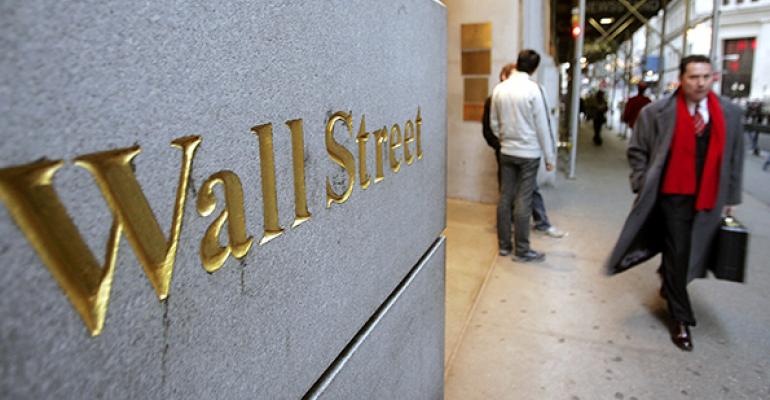(Bloomberg) -- Am I significant risk-taker?
That’s the question echoing across Wall Street after U.S. regulators released a proposal Thursday to delay bonus payments to key personnel at major financial firms. The term was assigned to employees at companies including banks, brokerages and asset managers who -- in addition to a more specific list of senior executives -- would face restrictions on taking home compensation.
The proposal was surprisingly stiff, and as lawyers, bankers and pay consultants scrambled to identify how many people qualify and to what degree the new rule may reshape existing practices, many of them were struggling.
“I have a headache,” said Rose Marie Orens, a senior partner at Compensation Advisory Partners. “If you work on Wall Street, you’re going to need a calculator.”
And, quite possibly, more information from your bosses.
The incentive compensation rule is one of the most sweeping (and delayed) measures to stem from the 2010 Dodd-Frank Act, aimed at preventing a repeat of the global financial crisis. It would extend and toughen deferred-pay and clawback clauses already stitched into employment contracts at many large financial firms -- especially global banks. At the biggest firms, top executives will have to wait at least four years to collect most of their bonus. And companies can reclaim pay -- even if it already has vested -- for as long as seven years if an employee took inappropriate risks.
It’s been a six-year rulemaking saga. Regulators scrapped an earlier version in 2011 after a flood of criticism. In the meantime, they watched efforts in the U.K. and Europe. For the sake of consistency, U.S. authorities said Thursday, “international coordination in this area is important.”
The rules will apply to major banks and about 131 brokerages, the Securities and Exchange Commission estimated Thursday.
One group that was spared arguably makes up the biggest risk-takers of all: hedge-fund managers. Most will dodge the new deferrals and clawback provisions because their firms have far fewer assets than banks. Of the 669 registered investment advisers subject to the proposed rule -- some of which are hedge funds -- 630 would fit into the most lightly regulated category reserved for firms with less than $50 billion of consolidated assets, according to the SEC.
The Tests:
However, if your firm is covered by the rules, and you want to figure out if you’re affected, follow the set of tests outlined by regulators. For starters, if you’re not pulling in a bonus that accounts for at least a third of your total pay, you can sit down. Not a risk-taker.
If you’re still standing, do you have a say over at least 0.5 percent of your company’s total capital? JPMorgan Chase & Co., the biggest U.S. bank, had $177.5 billion of capital at the end of March, so the rule would apply to anyone who can commit or expose $888 million of that stockpile. If that sounds like you, you’re affected. If not, don’t sit down quite yet.
Are you among the top 5 percent of earners at your firm? For many on Wall Street, the answer to that question will be a guesstimate, because pay is closely guarded. Go have a chat with your bosses.
JPMorgan had total staff of about 234,600 at the end of March, so theoretically 11,700 people will be within its top 5 percent. The investment bank doesn’t publicly disclose a breakdown of base pay and incentive compensation across its workforce. Figuring out who’s in that tier is a challenge.
The Caveats:
If you don’t fit those definitions of a risk-taker, you’re not necessarily safe. Regulators are reserving the power to flat-out name you one, if they think you fell through the cracks. On the flip side, they can also decide to cast a smaller net if they conclude your firm doesn’t need the extra scrutiny.
Even if you aren’t deemed a risk-taker, that doesn’t mean life won’t change. As firms implement new policies for top employees, there’s a good chance they’ll take a more comprehensive look at compensation practices lower down. Otherwise, what will the incentive be to become a significant risk-taker?
The proposed rule “is very significant” said Joe Sorrentino, a compensation consultant at Steven Hall & Partners in New York. “For people on Wall Street, the way they will get paid has just gotten more complex, and there’s a significant chance that their pay could be reduced.”
Affected Companies
Still wondering if your company is included?
The rules apply to all financial firms that have more than $1 billion in assets. Above that, regulators divide companies into three types based on size. At firms exceeding $250 billion of assets, senior officers will have 60 percent of their bonus withheld for four years while risk-takers wait for 50 percent. At firms with assets of $50 billion to $250 billion, top officials would see half of their bonuses deferred for at least three years, while risk-takers wait for 40 percent. Firms below $50 billion face some obligations but aren’t subject to the deferral and clawback clauses.
There’s still a lot that can change. Five agencies have to sign on to Thursday’s rule, only released so far by the National Credit Union Administration. The regulators intend to take public comments until July 22 before what promises to be more months of negotiation over a final version -- and potentially years of implementation.
--With assistance from Yalman Onaran, Anders Melin and Miles Weiss. To contact the reporters on this story: Elizabeth Dexheimer in Washington at [email protected] ;Jesse Hamilton in Washington at [email protected] To contact the editors responsible for this story: Jesse Westbrook at [email protected] David Scheer, Alan Goldstein





